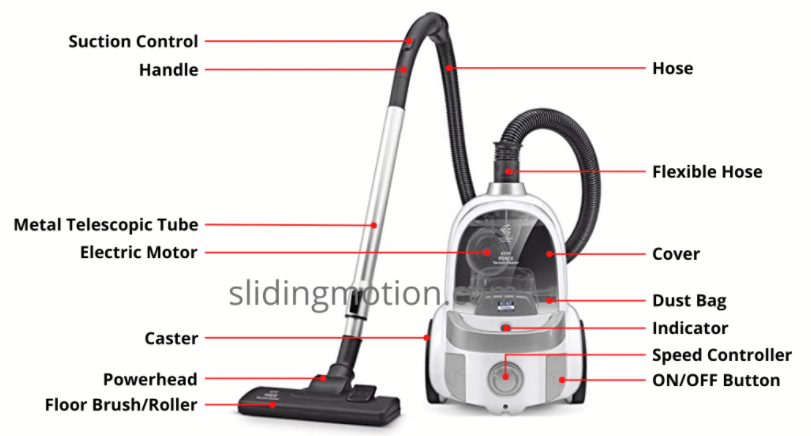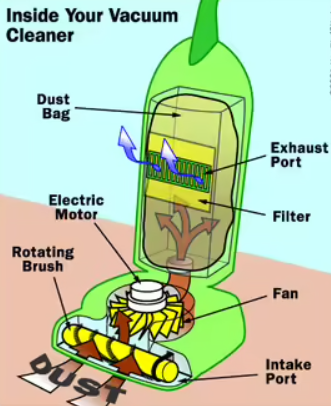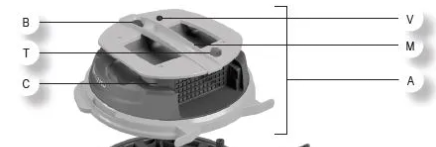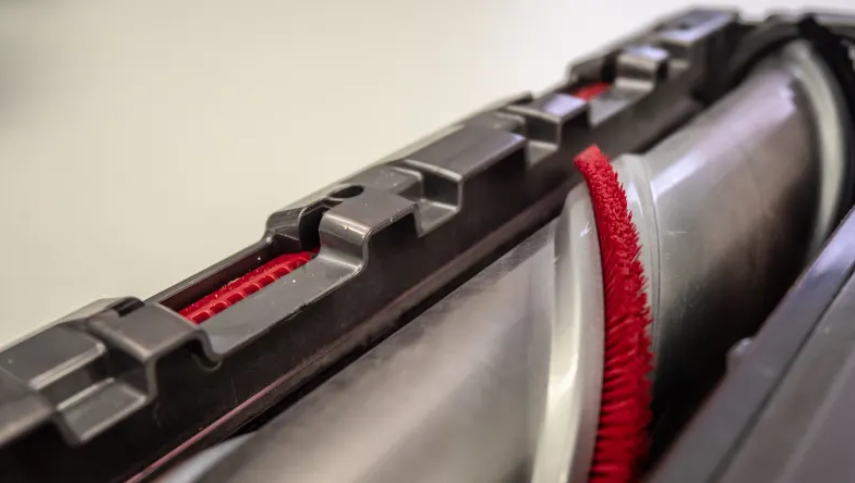Introduction
A vacuum cleaner is one of the essential technical items for dry house cleaning, and people have been actively using distinct variations of this device for more than a century. It is generally accepted that the prototype of an electric vacuum cleaner was invented by James Spangler in 1907 in the United States (Bellis, 2020). He combined the existing versions of a gasoline-based cleaner and a manual sweeper, receiving the patent for the first vacuum cleaner (Bellis, 2020).
This innovation was necessary due to the fact that older prototypes were unsanitary and less effective in dry cleaning. They contributed to chronic coughing, allergies, and other unhealthy physical reactions; hence, there was an urgent need to improve the device (Bellis, 2020). The current paper provides a thorough overview of a simple electric vacuum cleaner and describes its primary parts and functions.
Technical Description
At present, cleaning companies continually invent new models of vacuum cleaners, including autonomous robot models and lighter portable versions. They become increasingly complicated and have many unique features, complex sub-components, and other associated characteristics. These innovative models do not fit the scope of the assignment due to technical complexity and a large number of parts. Hence, the current paper examines the most basic version of an electric vacuum cleaner.
General Overview
Vacuum cleaners are electric devices that utilize a suction feature to extract dust and small pieces of debris from surfaces. Figure 1 below presents a general overview of a standard vacuum cleaner:

As seen from the figure, the primary components include an electric motor, a hose, a floor brush, and a dust bag (“Parts of vacuum,” 2022). A standard vacuum cleaner is a relatively simple technical item; however, it has a few essential interior and exterior parts that are necessary for optimal work.
Interior Parts
The current chapter examines the interior parts of the device, including an exhaust port, an intake port, a dust bag, a filter, and an electric motor. An electric motor is the most vital component in this list since it enables the suction feature (“Parts of vacuum,” 2022). In Figure 2 below, the motor is connected to a fan that generates the suction power:

Motor Overview
The electric motor is the central interior item in vacuum cleaners because it generates power and makes the device function. Without it, there would be no energy source to create suction power for cleaning. The motor forces the attached fan blades to move at a large speed of approximately 3,000-35,000 Revolutions per Minute (RPM), which designates the average motor rotating power (“Parts of vacuum,” 2022). The older versions (depicted in Figure 1) generally had around 3,000-10,000 RPM, while the new devices may reach 150,000 RPM (Quinones, 2021). This number translates into how fast the electric motor can move the fan blades, designating the overall level of suction power. Figure 3 below presents the basic motor structure, consisting of several components:

Ports Overview
Exhaust and intake ports play a secondary role in suction power generation since they affect the direction of air flowing through the device. As seen in Figure 2, an intake port is a slot through which the air is flowing into the device (Harris, n.d.). Consequently, the air leaves the vacuum cleaner through the exhaust port. As a result, there is a consistent air stream flowing through the device, enabling the suction feature (Harris, n.d.). While the exhaust and intake ports are simple items, they are secondary crucial technical components that enable optimal work of vacuum cleaners.
Filter Overview
Lastly, filters and dust bags are crucial parts that separate the air particles from dust and small pieces of trash. There is a large variety of filtering mechanisms in state-of-the-art models that can screen all objects flowing through the vacuum cleaner (“Parts of vacuum,” 2022). In this sense, a dust bag is one of the most common and basic filter variations that can separate dust and debris from the air, making the whole work more hygienic (“Parts of vacuum,” 2022).
If there were no filters in vacuum cleaners, people would have suffered from chronic coughing, allergies, and other undesired conditions caused by dust particles. This approach to cleaning was one of the reasons for the invention of electric vacuum cleaners initially, and a high level of hygiene remains one of the most notable advantages of the device (Bellis, 2020). Lastly, the filtered objects, including dust and debris, enter the collecting bin, which has to be cleaned afterward manually.
Exterior Parts
Exterior parts refer to the components that can be seen without dismantling the device. They primarily include a hose, a floor brush/roller, a tube, and a housing/metallic case (see Figure 1). Exterior components do not directly affect the suction mechanism of vacuum cleaners; however, they provide many additional benefits that make the process more convenient. Figure 4 below demonstrates the detachable exterior components of a standard vacuum cleaner:

Hose and Tubes Overview
A flexible hose and a metallic tube are the most noticeable exterior items that define a standard electric vacuum cleaner. A typical flexible hose is made of rubber and plastic, and it is designed for convenience purposes (“Parts of vacuum,” 2022). It allows the user of the device to reach remote places and increases the overall comfort of handling. A metallic tube makes the suction function more effective, creating a favorable environment for unobstructed air inflow (“Parts of vacuum,” 2022). Moreover, the material of the tubes is generally antiallergic, resulting in a more hygienic process. Hence, hoses and tubes are significant components of a standard vacuum cleaner.
Floor Brush or Roller
There are multiple names for the attachment at the end of the hose, but it notably increases the effectiveness of dry cleaning. Namely, a floor brush has a rolling mechanism with bristles that continually swirls the surface, lifting the dust particles and debris (see Figure 5).

It plays a crucial function and enables the cleaning of unequal surfaces, such as carpets and rugs. In other words, a combination of a roller and bristles lifts small debris hidden in the carpet fibers (MacDougall, 2022). It makes vacuum cleaners much more versatile and appropriate for cleaning various surfaces, ranging from hard floors to dense rugs. Hence, a roller brush is a crucial component that differentiates electric vacuum cleaners from other manual methods of dry cleaning.
Vacuum Cleaner Functions
Lastly, it is essential to discuss the functions of a standard vacuum cleaner. While newer devices have many additional features, such as wet cleaning and enhanced suction power, the primary function of a traditional vacuum cleaner is dry cleaning. It occurs due to a difference in air pressure inside and outside the device (Harris, n.d.). Similar to sipping from straws, this pressure difference creates suction power, which enables dry cleaning (Harris, n.d.).
The effectiveness of suction directly depends on the characteristics of the electric motor and RPM, as more advanced models have lower air pressure inside the device (Harris, n.d.). As air moves through the tube and the hose, it collects dust and debris from surfaces. It is a relatively simple but effective method of dry cleaning, which has been the primary function of vacuum cleaners for more than a hundred years.
Conclusion
Vacuum cleaners are irreplaceable technical items that make house cleaning much more time-efficient, convenient, and hygienic. Before the invention of the device in 1907, people struggled with dry cleaning since dust and debris provoked chronic coughing and many allergies. The vacuum cleaner was a necessity in housework, and it drastically changed the way people clean their homes. While a standard vacuum cleaner might seem like a complicated item at first, it only comprises several interior and exterior components and operates due to the difference in air pressure. Ultimately, nearly every household has a vacuum cleaner for dry cleaning, and it is important to understand its primary parts and functions.
References
Bellis, M. (2020). The invention and history of the vacuum cleaner. ThoughtCo. Web.
Harris, T. (n.d.). How vacuum cleaners work. How Stuff Works. Web.
MacDougall, J. (2022). Ever wonder about the ‘vacuum’ in a vacuum cleaner? Here’s how it works. Reviewed. Web.
Parts of vacuum cleaner, names, functions & diagram. (2022). Sliding Motion. Web.
Quinones, J. (2021). Modern motor design cleans up the portable vacuum. Qorvo. Web.